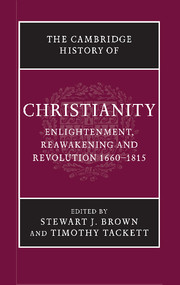Book contents
- Frontmatter
- Introduction
- PART I CHURCH, STATE, AND SOCIETY IN THE EUROPEAN WORLD, 1660–1780
- PART II CHRISTIAN LIFE IN THE EUROPEAN WORLD, 1660–1780
- 5 The Catholic clergy in Europe
- 6 The Protestant clergies in the European world
- 7 Reaching audiences: Sermons and oratory in Europe
- 8 Christian education
- 9 Christianity and gender
- 10 Popular religion
- 11 Jewish–Christian relations
- 12 Architecture and Christianity
- PART III MOVEMENTS AND CHALLENGES
- PART IV CHRISTIAN DEVELOPMENTS IN THE NON-EUROPEAN WORLD
- PART V REVOLUTION AND THE CHRISTIAN WORLD
- Chronology
- Bibliography
- Index
- References
11 - Jewish–Christian relations
from PART II - CHRISTIAN LIFE IN THE EUROPEAN WORLD, 1660–1780
Published online by Cambridge University Press: 28 March 2008
- Frontmatter
- Introduction
- PART I CHURCH, STATE, AND SOCIETY IN THE EUROPEAN WORLD, 1660–1780
- PART II CHRISTIAN LIFE IN THE EUROPEAN WORLD, 1660–1780
- 5 The Catholic clergy in Europe
- 6 The Protestant clergies in the European world
- 7 Reaching audiences: Sermons and oratory in Europe
- 8 Christian education
- 9 Christianity and gender
- 10 Popular religion
- 11 Jewish–Christian relations
- 12 Architecture and Christianity
- PART III MOVEMENTS AND CHALLENGES
- PART IV CHRISTIAN DEVELOPMENTS IN THE NON-EUROPEAN WORLD
- PART V REVOLUTION AND THE CHRISTIAN WORLD
- Chronology
- Bibliography
- Index
- References
Summary
I am a Jew! Hath not a Jew eyes? Hath not a Jew hands, organs . . . If you prick us, do we not bleed? . . . if you wrong us, shall we not revenge?
I will buy with you, sell with you, talk with you, walk with you . . . but I will not eat with you, drink with you, nor pray with you.
Strangers in foreign lands
In the Merchant of Venice, Shakespeare captures both the ambiguity of Jewish–Christian relations in early modern Europe and the myths surrounding the Jew, the blood-thirsty usurer of medieval legend, ‘the very devil incarnation’. Moreover, Shylock’s oft-quoted insistence, that as a human he differs not at all from Christians and that as a Jew he must dwell apart with his own traditions, practices, and laws, gives voice to an enduring tension not only in Jewish history but also in any attempt to relate to the demythologized Jew, in any attempt to welcome Jews into the body politic.
Shakespeare probably never met a Jew, since there were no more than a hundred living in London and Bristol. Expelled from England in 1290, they had no legal guarantee of existence and were only semi-overt in their religious practices. By 1609, even these few Jews had disappeared. Indeed, by the middle of the seventeenth century, no Jews could be found in Spain, Portugal, France and parts of Germany as well as in England.
By the end of the eighteenth century, except for the Iberian peninsula, Jews had returned to Europe, numbering 175,000 in Germany, 70,000 in the Austrian Empire, 100,000 in Hungary, 40,000–50,000 in France, 50,000 in Holland, and 25,000 in Britain. These numbers represented not only a demographic change but reflected as well the beginnings of an amelioration in Jewish–Christian relations, whose contours remained in flux throughout the nineteenth and twentieth centuries.
- Type
- Chapter
- Information
- The Cambridge History of Christianity , pp. 208 - 225Publisher: Cambridge University PressPrint publication year: 2006



